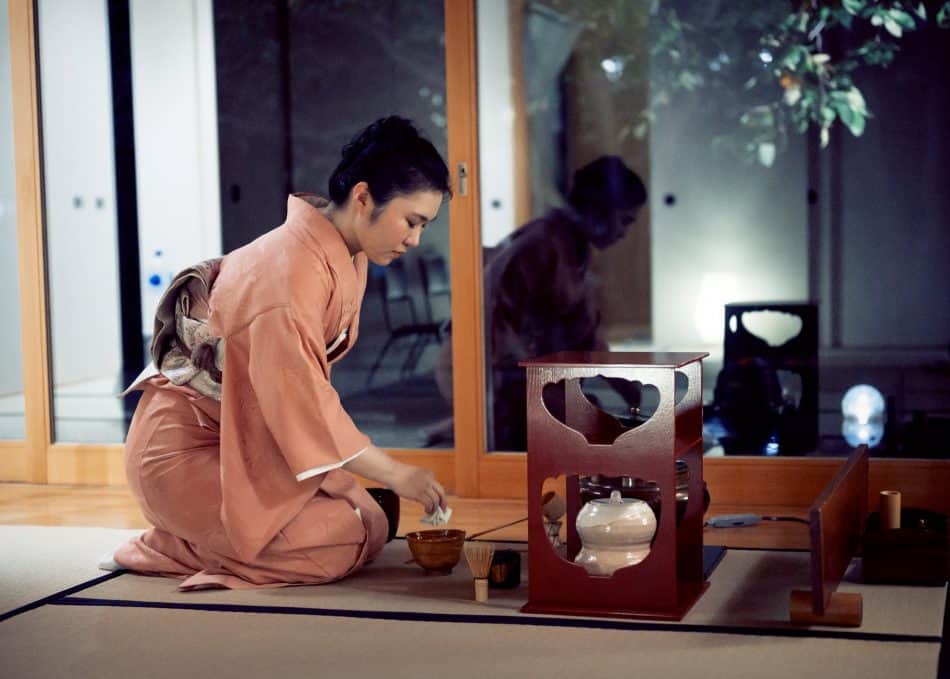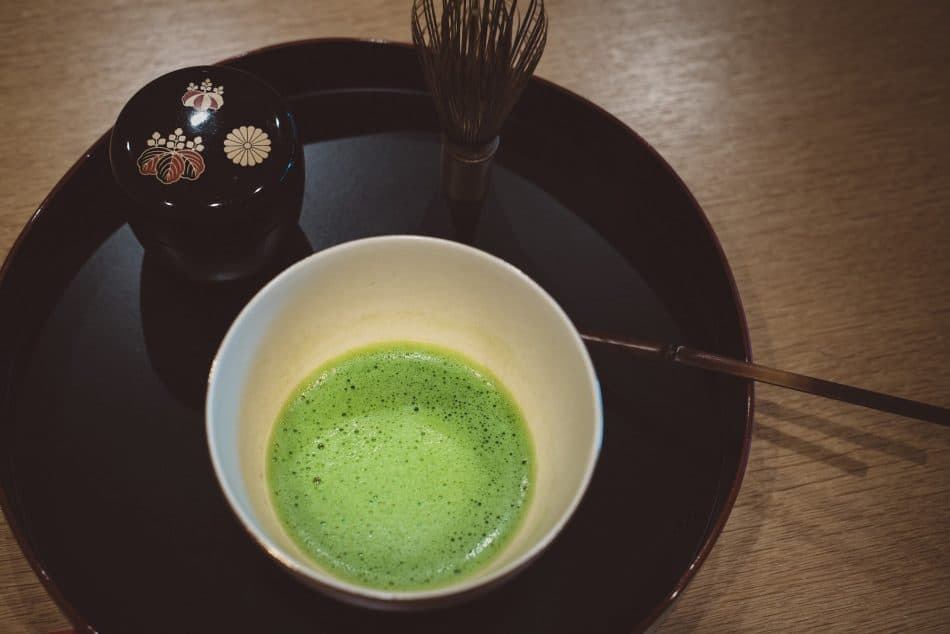Each time I practice tea ceremony, I liken my practice to a wave breaking on a rocky shoreline. Eventually, the waves transform the sharp rock into soft velvety sand, but even after the waves have washed over the shore for decades, that transformation is difficult to discern. Meanwhile, in America, I’ve been told if this webpage doesn’t load in less than 3 seconds, 71% of you won’t even read it. This is the problem a Californian like me faces when learning Japanese tea ceremony: a dichotomy of expectations.
What Foreigners Love About Japanese Tea Ceremony
New visitors and residents alike have listed participating in Japanese tea ceremony on their Japan Bucket List. There is a valid reason for this; Japanese tea ceremony ticks off a myriad of characteristics of things people love about Japan: aesthetic, hospitality, culture, and food. You are graciously welcomed into a lovely tatami room by an immaculate kimono-clad woman (or man, let’s not be sexist). In an alcove on the wall known as the tokonoma, a lovely handwritten scroll hangs alongside a seasonally appropriate arrangement of flowers. You are offered a delicate wagashi, a Japanese sweet in the shape of a flower, object, or animal, also in accordance with the season. Finally, your host presents you with a delicate bowl, handed to you so you can admire the beautiful craftsmanship of its design. Inside the bowl is the shockingly green matcha with the scent of a freshly mowed lawn.
But usually, that is it. Experience done, crossed off the bucket list, moving on to Tokyo cart racing. For a few, however, the experience lingers, a delicate fragrance they want to return to. Some love the peaceful rhythm of the ceremony, especially when it is performed with a natural cadence that seems unrehearsed, even if the truth is completely different. Some love the cultural aspect, an excuse to wear a kimono, making use of utensils that are sometimes museum-quality pieces of art.
Why I Practice Tea Ceremony
For me, tea ceremony is an intimate glimpse of the Japanese psyche. As one learning about Japan, paying attention to the details of the world of tea ceremony will teach you a lot about Japan’s culture and society.
Starting at the macro level, the act of serving tea itself tells us a lot about Japanese society. The concept of omotenashi おもてなし, hospitality, is at the center of Japanese tea ceremony. Each utensil used is thoroughly cleaned in front of the guest, demonstrating the importance of the guest to the host. The tea bowl is served with the most beautiful design facing the guest, who rotates the design away from himself before drinking so the other guests can enjoy it. Each item in the tea room is selected by the host to magnify the guest’s enjoyment of the event. For a 30-minute tea ceremony, it is not uncommon for there to be several days worth of preparation.
Pulling back, we see that tea ceremony is but one traditional art of many that are linked together in Japanese culture. Ikebana (flower arranging), shodo (calligraphy), kaisen ryori (gourmet cooking), kodo (incense appreciation), yakimono (pottery), and kimono are but a few. Those who practice tea are probably also practicing other Japanese traditional arts because to excel at tea ceremony requires competence in many different art forms. My teacher, for example, practices calligraphy and gourmet cooking while my friend and fellow student takes lessons in flower arranging. If it were even possible to master the art of tea ceremony, it would certainly not be possible to master every traditional art associated with it.
This is part of what makes the social aspect of tea ceremony important, sharing skills and experience to put on a single event. So we also see how Japanese relationships work, for better or worse. I once attended a tea event where the head of the tea ceremony association came to help a lower-ranking teacher. During the event, everything seemed perfectly normal, but later learned that the senior teacher was neither invited nor wanted; she inserted herself into the event because she wanted to attend. Though tea ceremony is practiced mainly as a leisure activity, there is a rigid structure of authority in tea ceremony that is parallel to how things work in many areas of Japanese society.
Practicing Tea Ceremony While Social Distancing
Of course, in the current state of the world, getting together to practice tea, even in small groups, isn’t the wisest decision. I suppose you could hop on Zoom and have a virtual tea ceremony with a group of friends, but I’m not convinced how delicious virtual tea would taste. Fortunately, the actual practice of tea ceremony can be done in your own home, provided you already know the steps.
You would think making Japanese tea would be quite simple, and in fact, the items you can use in place of proper utensils can be purchased inexpensively. A rice bowl can be used in place of a tea bowl, a fine-mesh strainer for sifting matcha powder, and the bamboo tea scoop and whisk are standard items at Daiso in America (though oddly, not at Daiso in Japan). Water can be boiled on the stove or in a hot pot (though a cooking thermometer is useful to reduce the temperature to 175F/80C for optimal matcha making). Over the years, I have collected or been gifted all of the utensils necessary to practice tea ceremony at home, so it is embarrassing to admit how infrequently I actually do it. We even have a washitsu, a Japanese tatami room, where I hang my scroll and display my loveliest utensils, which do little but collect dustballs. I am, in fact, a tea ceremony poser.
Perhaps part of my reluctance stems from the fact that I don’t LOVE matcha. There, I said it, so if you are like me, stand up, on a desk if you prefer, and proudly exclaim, “I don’t love matcha either!” Now I can drink a bowl of matcha once or twice a week, but when practicing tea, you might need to drink 2 or 3 bowls in a sitting. The idea of drinking that much matcha gets my arm hair standing up, let alone the actual results of consuming that much caffeine in one session. I could make it and not drink it, but that offends the Japanese sense of mottainai もったいない, not being wasteful.
More likely, I am deflecting from the fact that I simply don’t have the self-discipline to practice tea on a regular basis. My western self longs for a short version, a YouTube channel or Matrix-style brain upload, that will transform me into a competent tea ceremony host. For Japanese, it seems, the journey of experience is one to be enjoyed, or at the very least, endured. Nobody expects to become great overnight, nor do they expect to be born with a natural talent. It’s part of the Japanese psyche I most admire, mainly because I don’t have it. Yet. I’m working on it every day.
Finding Beauty in Tea Ceremony
Even if I never get good enough to host my own tea ceremony, one thing I will always enjoy is the beauty that tea ceremony encapsulates. The gracefulness of the actions, the harmony of the utensils, even the environment itself build on each other to create this beauty. Sadly, I’m not much of a tea ceremony photographer, but my friend has been documenting her tea practices and ceremonies for over a year now and has learned to convey this beauty in the simplicity of an Instagram post.
Perhaps, in the world of tea ceremony, my rocky seashore never becomes a sandy beach. Even so, I think I could be content in finding the beauty in watching the waves break on the shore.






